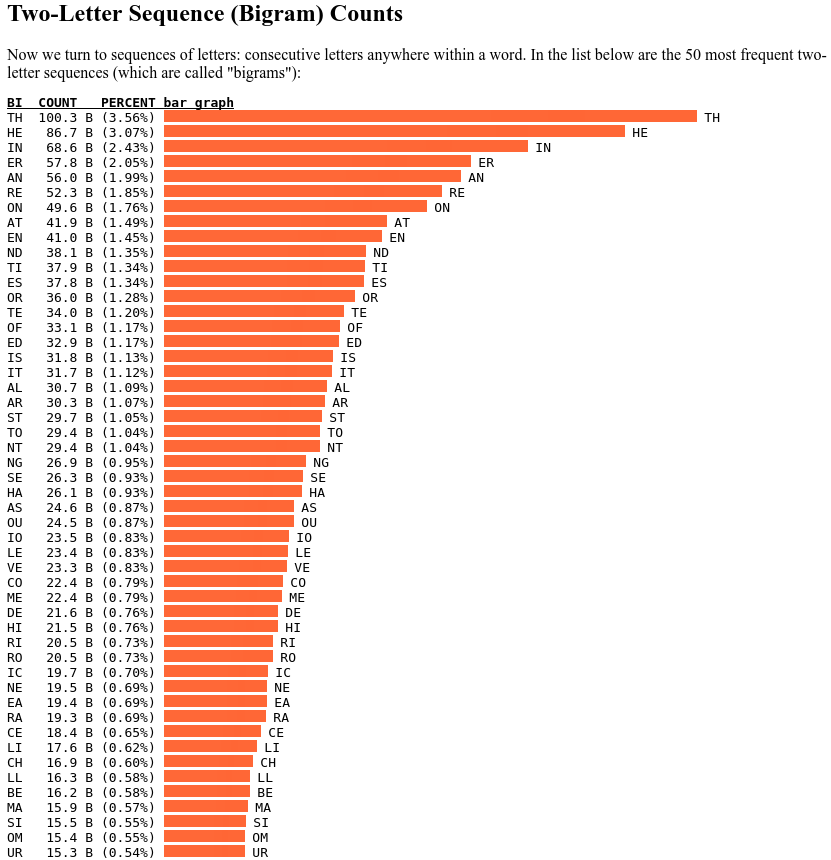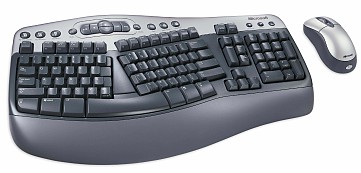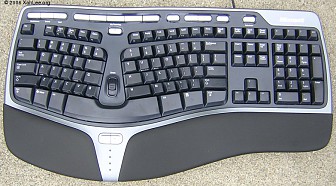What is the Most Efficient Keyboard Layout?
There are many alternative keyboard layouts, such as Dvorak, Colemak, etc. Which is best? 〔see Ergonomic Keyboard Layouts〕
Let's find out!
Flaws in Popular Keyboard Layout Studies
Here is 3 of the most popular sites that study keyboard layouts.
PAT's Keyboard Layout Analyzer
http://patorjk.com/keyboard-layout-analyzer/
by Patrick Gillespie
The app is very simple and visual oriented. It takes a input text, and computes simple distances and finger frequency among 5 layouts: {QWERTY, Dvorak, Colemak, Capewell, Arensito}. Plus, it also generates a new layout that is optimal for the input text you used.
MAJOR FLAW: The site only compare simple measures such as distances, row positions, and finger ease. It does not take consideration of ease of bigram, hand alternation, etc. (e.g. try to type “mommy you ok” in QWERTY.)

- English Letter Frequency Counts: Mayzner Revisited
- By Peter Norvig.
- http://norvig.com/mayzner.html
Michael Capewell's Keyboard Evolve
Michael Capewell, author of the Capewell layout, wrote a software Keyboard Evolve, that uses evolutionary algorithms to arrive at a optimal layout.
- Keyboard Evolve
- By Michael Capewell.
- http://www.michaelcapewell.com/programming/keyboardevolve.htm
Here is a quote:
Unfortunately, I have yet to find the holy grail of keyboard layout evolution parameters! Things are complicated by there being a fundamental difference in how curved, ergonomic keyboards and plain, rectangular keyboards are used — the way I see things, they have different home “rows.” This program works best for ergonomic keyboards. I'm in the process of finding the right balance between the two…
The moral here is:
What keyboard you use has more impact to hand health than layout.
Ergonomic Score of Letter Key Position Depends on the Underlying Physical Keyboard
For example, suppose, there's a command you need to call 2 hundred times a day (e.g. move cursor forward by word). You are wondering, if Ctrl+k is better or Alt+8. Which one of these is more comfortable, ergonomic?
The answer will depend on exactly which keyboard is used , even if you have 2 almost identical computer keyboards but made by different companies.
〔see Function Key vs Modifier Key Combination, Which is Healthier, Faster?〕
• The quality of the key, MATTERS significantly. Is it shallow as in laptop? is it deep like IBM Model M keyboard (1985)? is it mechanical key switch? Even on laptop, all using shallow keys with scissor-switch, different laptop have significant difference on how the typing feels.
〔see Mechanical Keyboard and Repetitive Strain Injury〕
• The physical key positions matters significantly. You might think that all computer keyboards are about the same. Not so. The exact position of Alt key actually differs depending on the keyboard. On some, it's to the lower left of x, while on others, it's lower right of x. On laptop, it varies more. Different ergonomic keyboard's various curves and alignment also have major impact. The precise position of a key has effect on how you press it, which in turn, has long-term effect on your hand health.
As an example, i was using Microsoft Wireless Natural Multimedia keyboard for ~4 years. Then i switched to the newer version, the Microsoft Natural Ergonomic Keyboard 4000
-
 Microsoft Wireless Natural Multimedia keyboard (2004)
Microsoft Wireless Natural Multimedia keyboard (2004) -
 Microsoft Natural Ergonomic Keyboard 4000 (2005)
Microsoft Natural Ergonomic Keyboard 4000 (2005)
On the new keyboard, i got Repetitive Strain Injury, and after 1 month hand tingling and discomfort, i discovered that it is because i was twisting my left wrist and use index finger to press keys like {1, 2, Tab, Escape, `}, and this bad habit is the cause of the RSI. however, this habit was only formed from using this newer model of Microsoft ergonomic keyboard, even though both models of the keyboard have very similar design, and the 4000 is supposedly more ergonomic.
For detail, see Programer Hand Pain. vim Escape Key Syndrome (2010)
Carpalx Study
- Carpalx, at http://mkweb.bcgsc.ca/carpalx/ , is a site dedicated to studying efficiency of keyboard layouts.
- The site is created in 2007 by Martin Krzywinski, a bioinformatics scientist.
- The study assumes English language, and assumes the standard computer keyboard physical key layout.
- It uses statistics to find a best model of efficiency measurements, then evaluate the different layouts.
- Carpalx is the most thorough study on keyboard layout efficiency and quite technical.
- You can spend several days studying the site.
- When you study keyboard layout as Carpalx did, one thing quickly becomes obvious.
- The difficulty in creating the “most efficient” isn't about computing distances or gathering statistics, but making subtle judgement on what's considered more efficient.
- For example, is minimizing distance of finger travel more important than alternating hands?
- How important do we assign to ease of bigram?
- What weight should we attach to avoiding single-finger repetition?
- Should the key J and K have a ease-of-press score difference of 0.1 or 0.2?
- According to him, the layouts from best to worst are: QFMLWY, QGMLWB, QGMLWY, Colemak, Dvorak, Capewell, Arensito, QWERTY.
- Full Optimization - Q*MLW* Layouts
- By Martin Krzywinski.
- http://mkweb.bcgsc.ca/carpalx/?full_optimization
MAJOR FLAW of Carpalx study:
- Carpalx's program assumes the punctuation keys {, . /} on QWERTY are fixed. This is quite strange. He seems to assume that those key positions are already perfect. Which is absolutely not true, in particular the comma. Comma's key position is relatively easy on fingers, by curling middle finger to press it, but comma is rarely used in comparison to most letters, so shouldn't have a easy key spot.
- Carpalx does not consider positions of special keys, e.g. {Enter, Tab, Backspace ⌫}. The Backspace ⌫ key, for example, is one of the most used key. You need to press it multiple times, happens in bursts, or holding it down often. The Tab is very frequently used by programers, for keyword completion.
Problem Ignoring Hardware Key Layout
Keyboard layout studies on the web always assume the common computer keyboard's physical key layout.
It's easy to write a computer program to compute the various frequencies and distances of the computer keyboard's keys. It is also easy to create a keyboard layout. But it is difficult to invent a different physical key layout that fixes some serious computer keyboard problems. Thus, all online layout studies simply focus on shuffling of the keys.
(since 2013, there's a explosion of modern ergonomics keyboards that do explore the ergonomics of hardware layout. example: ergodox, keyboard.io, Microsoft sculpt, truely ergo, Esrille, uTRON, etc. See Ergonomic Keyboard Reviews)
Tab Enter Shift Break Ya Fingers
The computer keyboard's physical-key layout has several major flaws with respect to ergonomics. For example, the {Enter, Tab}, are frequently used keys but requires the pinky to press.
The Backspace ⌫ is most frequently used, but it's in a awkward position, you press it with stretched pinky or ring finger, or twist wrist to press with middle finger.
The {Enter, ⇧ RShift, Backspace ⌫} keys require the pinky to stretch over 1 column of keys. If you are using a European keyboard 〔see QWERTZ, AZERTY〕, then there's 2 extra columns of keys for your pinky to stretch over to reach Enter.
〔see Keyboard Design Flaws〕
From statistics of emacs commands, the percentage of editing related keystroke (such as Tab, Return, Backspace ⌫) is 48% of all keystrokes! 〔see Emacs's Command Frequency〕
From my recent experience, if you just type the Enter key and Tab key all day, just these two keys and nothing else, on a standard computer keyboard with rubber dome key switch, with hands at touch-typing positions, do it once every second, for 8 hours, you'll get RSI fast. 〔see Programer Hand Pain. vim Escape Key Syndrome (2010)〕
The Load of the Pinky
Here is standard US layout without slant. Note the 5 extra keys for you right pinky.
` 12345 67890 -= qwert yuiop []\ asdfg hjkl; ' zxcvb nm,./
Another problem of computer keyboard's physical-keys layout is that the right hand has 5 more letter/symbol keys than the left, and all of them are pressed by stretched pinky. Especially important for programers, some of these keys are: {[, ], {, }, =, +}. These keys are used more often than z, for example. 〔see Computer Languages Characters Frequency〕
Just How Much Do You Type?
If layout X is better than layout Y by 1% when using Shakespeare's work as input, but will your life time's typing get that 1% benefit?
If your typing doesn't come anywhere close to a data-entry clerk, then any layout “more efficient” than Dvorak may not mean much.
Many programers claim they type all day. If you log your keystrokes, you may find that you actually just type less than 30 minutes per day if typed continuously. For detail, see: How Many Keystrokes Do You Type a Day? .
Keybinding Layout is More Important!
vi users often develop RSI due to vi Esc key Syndrome. Emacs users may develop the Emacs Pinky Syndrome due to Control and Alt key combinations.
From a study of Emacs's Command Usage Frequency, statistically, 50% keystrokes are for editing commands (e.g. moving cursor, deleting words). For most programers, less than 50% of keystrokes are entering letters.
So, if you are a programer, the layout for command keybinding are equal or more important than the layout of the letter keys.
Ergonomics of Keyboard is More Important!
If you are using standard straight computer keyboard or laptop keyboard, it would be far more significant in efficiency and hand health to switch to a ergonomic keyboard than using improved letter layout.
For some choices of keyboard that improve the computer keyboard physical key layout, see: Best Ergonomic Keyboards, Xah Pick .
Keyboard layout design
- Keyboard Layout Design 🔠
-
Ergonomic keyboard Layouts
-
Thumb Keyboard Layouts
- Most Efficient Layout?
- QWERTY Layout
- Dvorak Layout
- Maltron vs Dvorak
- Colemak Layout (2005)
- Workman Layout (2010)